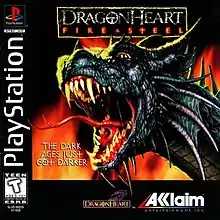DragonHeart: Fire & Steel
Dragonheart: Fire & Steel (stylized as DragonHeart: Fire & Steel) is a video game loosely based on the 1996 fantasy adventure film Dragonheart. On most systems it is a 2D side-scrolling action game, but the Game Boy version is an adventure game with combat scenes, where adventure mode uses a first-person view and combat mode is a simple 2D fighting game.
| Dragonheart: Fire & Steel | |
|---|---|
 | |
| Developer(s) | Funcom (Console & PC versions) Torus Games (GB version) |
| Publisher(s) | Acclaim Entertainment |
| Platform(s) | PlayStation, Sega Saturn, Windows, Game Boy |
| Release | Game Boy
|
| Genre(s) | Hack and slash, platform |
| Mode(s) | Single-player |
Plot
Dragonheart: Fire & Steel follows the story of medieval dragonslayer Sir Bowen in his attempt to rid the world of a particularly evil king along with seven evil dragons that have ruled the world (the seven evil dragons never appeared in the film). On the way, he befriends the last dragon to exist, Draco. Sir Bowen and Draco must join forces to defeat the king's army and rescue a damsel in distress. It drops out some of the film's plot, but it is still a close match.
Reception
| Publication | Score |
|---|---|
| AllGame | |
| Electronic Gaming Monthly | 4.5/10 (PS1)[4] |
| GameSpot | 2.8/10 (PS1)[5] 3.4/10 (PC)[6] |
| Next Generation | |
| Sega Saturn Magazine | 27% (SAT)[8] |
| Manic Games | 28/100 (SAT))[9] |
After its release, Dragonheart spawned a spin-off 2D hack and slash game for the PlayStation and Saturn called Dragonheart: Fire & Steel, made by Acclaim Entertainment. The game does not use the film's music, instead featuring an original score by Thomas Egeskov Peterson.[10] It was met with overwhelmingly negative reviews due to simplistic gameplay,[4][7][8] poor controls,[4][5][7][11] and jerky animation.[4][7][8][11] Though the graphics were praised, particularly the rendered backgrounds, critics agreed that the gameplay problems were an overriding problem.[4][5][7][11] In late 1996, Acclaim ported a PC version of the game, which received similar criticism.[6]
There was also an original Game Boy game based on the film, titled simply Dragonheart. The four reviewers of Electronic Gaming Monthly, while remarking that the Game Boy game is rather simple and lacking in challenge, especially the "anticlimactic" combat, concluded that it offers decent entertainment and longevity for a portable game. They especially praised the storyline, with Sushi X going so far as to say it was the main reason he kept playing the game.[12]
Reviews
- GameFan #50 (vol. 5, issue #2) - February 1997
- PC Games (Germany) - January 1997
- PC Player (Germany) - January 1997
References
- "Online Gaming Review". 1997-02-27. Archived from the original on 1997-02-27. Retrieved 2023-04-16.
- L. House, Michael. "Dragonheart: Fire & Steel". AllGame. Archived from the original on November 16, 2014. Retrieved October 18, 2020.
- Thompson, Jon. "Dragonheart: Fire & Steel". AllGame. Archived from the original on November 15, 2014. Retrieved October 18, 2020.
- "Review Crew: Dragonheart". Electronic Gaming Monthly. No. 90. Ziff Davis. January 1997. p. 72.
- Soete, Tim (9 January 1997). "Dragonheart Review". GameSpot. Archived from the original on 29 January 2018. Retrieved 29 January 2018.
- Varner, Jim (February 4, 1997). "Dragonheart: Fire & Steel Review". GameSpot. Archived from the original on January 29, 2018. Retrieved May 9, 2011.
- "Dragonheart: Fire & Steel". Next Generation. No. 28. Imagine Media. April 1997. p. 118.
- Nutter, Lee (May 1997). "Review: Dragonheart". Sega Saturn Magazine. No. 19. Emap International Limited. pp. 60–61.
- Bannert, Robert (2019-01-15). "Dragonheart: Fire & Steel - im Klassik-Test (SAT)". MANIAC.de (in German). Retrieved 2019-05-02.
- "Dragonheart: Fire & Steel: Grab Your Sword for a Wild Ride". Electronic Gaming Monthly. No. 88. Ziff Davis. November 1996. pp. 210–1.
- "Saturn ProReview: Dragonheart: Fire & Steel". GamePro. No. 104. IDG. May 1997. p. 94.
- "Review Crew: Dragonheart". Electronic Gaming Monthly. No. 85. Ziff Davis. August 1996. p. 26.